Canyoning in Sierra de Guara, tucked away in the beautiful Aragon region of Spain, is an adventure I’ll remember forever.
The dramatic limestone cliffs, sparkling emerald pools, and winding river gorges make this place a dream for anyone craving a wild escape. If you’re itching for a unique way to see Spain, canyoning here mixes adrenaline, jaw-dropping scenery, and just pure fun.
Sliding down waterfalls, leaping into icy pools, and rappelling along rocky canyon walls—these moments stand out in my memory. Local guides kept things safe and, honestly, way more thrilling than I’d expected.
It’s an adventure that made me see Aragon in a totally new way.
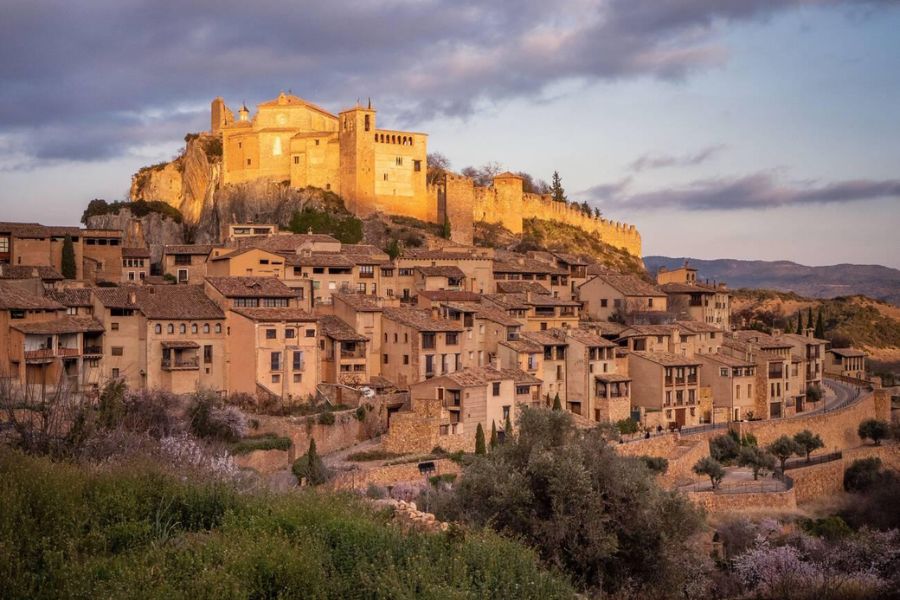
Every splash, every jump, brought this fresh sense of wonder. Whether you’re new to canyoning or you live for outdoor challenges, Sierra de Guara’s canyons have something to surprise you.
I left with a new appreciation for how much Spain offers beyond its famous cities.
Setting the Scene: Sierra de Guara’s Unique Landscape
Sierra de Guara is full of contrasts. Limestone cliffs slice through green valleys, turquoise rivers cut deep canyons, and old villages sit quietly among wild, rocky hills.
Geological Wonders of Aragon
This region is loaded with limestone massifs that water has shaped over millions of years. Standing at the edge of these cliffs, I couldn’t help but feel amazed at nature’s slow, patient work.
Rain and rivers have carved deep, narrow gorges—sometimes just a few meters wide. The rock glows white and orange, shining in the Spanish sun.
Canyons like Vero, Mascún, and Peonera attract outdoor lovers from all over Europe. The blue-green water stays cool, even when the sun blazes.
When I hiked or swam through these gorges, I noticed smooth potholes and steep drops—nature’s own playground, and a reminder that water rules here.
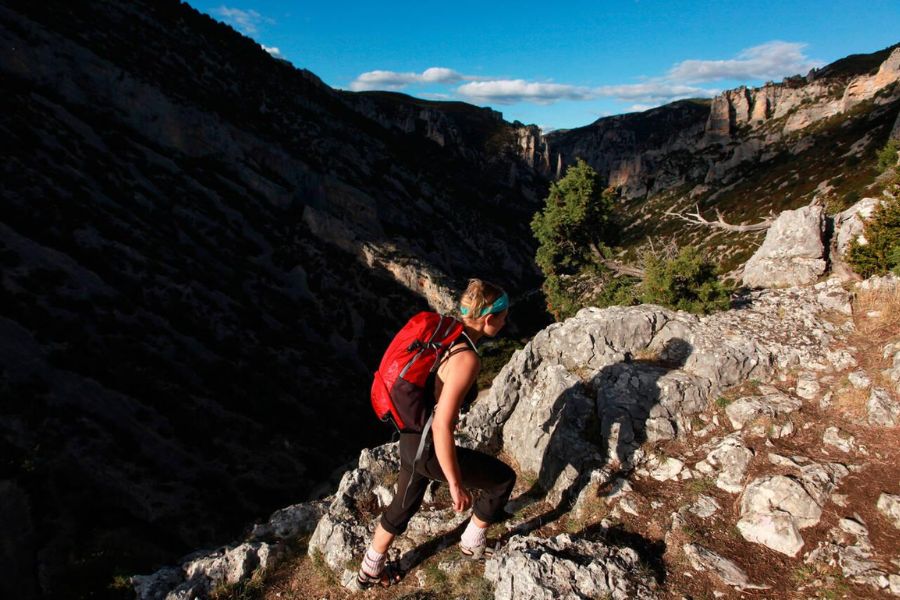
Most of the canyons form from karstic rock. This stone erodes in wild ways, creating caves, arches, and natural slides.
After every storm, the landscape shifts—new paths appear, rocks move, and you never quite know what you’ll find next.
National Parks and Nature Reserves
Right in the heart of Sierra de Guara, you’ll find the Sierra y Cañones de Guara Natural Park—the largest protected area in Aragon.
The park stretches over 47,000 hectares and shelters dozens of canyons. I loved how park rangers work hard to protect rare species like the bearded vulture and Bonelli’s eagle.
Even on marked trails, I could hear birds calling and spot wild ibex on the cliffs.
These protected lands aren’t just for canyoning. They offer hiking and biking routes, sweeping viewpoints, and shady picnic spots.
Having a park map made it easier to plan my days and discover not just the popular canyons but also hidden springs and waterfalls.
Entry is free and open all year. Some areas do close off during wildlife nesting seasons, though.
Local guides suggest visiting between late spring and early autumn for the best weather and safest water levels.
A Tapestry of Pueblos and Cities
Nature might steal the spotlight in Sierra de Guara, but small pueblos like Alquézar and Rodellar add a special kind of charm.
As I wandered narrow cobblestone streets, I found old stone arches, tiny chapels, and cozy cafés.
Alquézar, perched above the Río Vero, felt like a step back in time. The medieval castle and ancient bridge offered quiet places to rest after a day in the wild.
Rodellar, a hotspot for climbers, had a chill vibe and friendly local shops.
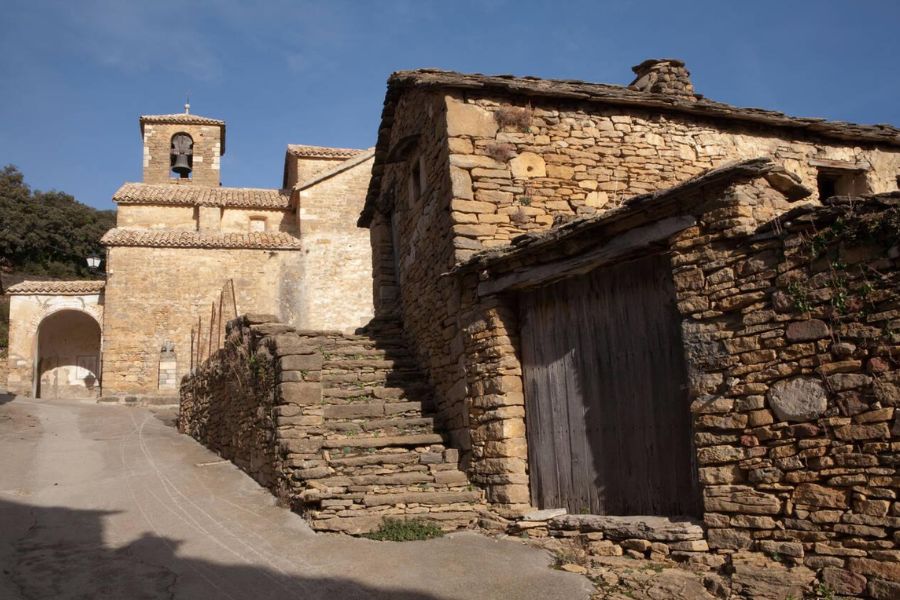
Nearby Huesca is the region’s main city and made a perfect base for exploring the park. I easily found gear rental shops, bustling markets, and some seriously good bakeries there.
Taking a day to explore the city gave me a taste of local culture and a much-needed rest before heading back outdoors.
Planning the Adventure: How to Experience Canyoning in Sierra de Guara
Canyoning in Sierra de Guara took a bit of planning, but honestly, that made the adventure even better.
From picking the right time, to choosing a route and sorting out gear, every detail added to the experience.
Best Time to Go and Seasonal Insights
It’s not just about the weather—water levels and safety shift with the seasons. Late spring to early autumn (May to September) works best.
The water warms up, and most routes open for adventure.
July and August get busy, so I found the canyons a bit crowded then. If you want a quieter vibe, June or September are cooler and less packed.
Heavy rain can make some canyons risky, so I checked local conditions before heading out.
Outside peak season, some guiding companies take a break or only run easier routes. I learned to keep my dates flexible in case the weather acted up.
Packing a neoprene wetsuit was a smart move, especially in cooler months or after storms.
Choosing the Right Route: From Beginner to Thrill-Seeker
Sierra de Guara has routes for every level:
| Route | Difficulty | Features |
|---|---|---|
| Vero Canyon | Beginner | Scenic, gentle pools |
| Peonera Inferior | Intermediate | Natural slides, short jumps |
| Mascún Canyon | Advanced | Long abseils, technical |
I kicked things off with a gentle descent, guided by an instructor. For families or beginners, Vero Canyon is perfect—calm pools, easy scrambles, no experience needed.
If you’re chasing a bigger thrill, Mascún or Gorgas Negras bring big drops and longer swims.
Booking with a local adventure sports company gave me access to expert guides and quality gear. They matched the route to my skills and fitness, which made the day both safe and genuinely fun.
Essential Gear and Safety Tips
Staying safe in Sierra de Guara’s canyons starts with solid gear. Here’s what I brought:
- Helmet and harness for abseiling
- Neoprene wetsuit (even in summer)
- Old sneakers or canyoning shoes for grip
- Waterproof backpack for snacks and water
- Dry bag for phone or camera
Guided tours usually supply the basics, but I always double-checked. Hydration matters—scrambling and swimming can wear you out.
I kept a small first-aid kit just in case.
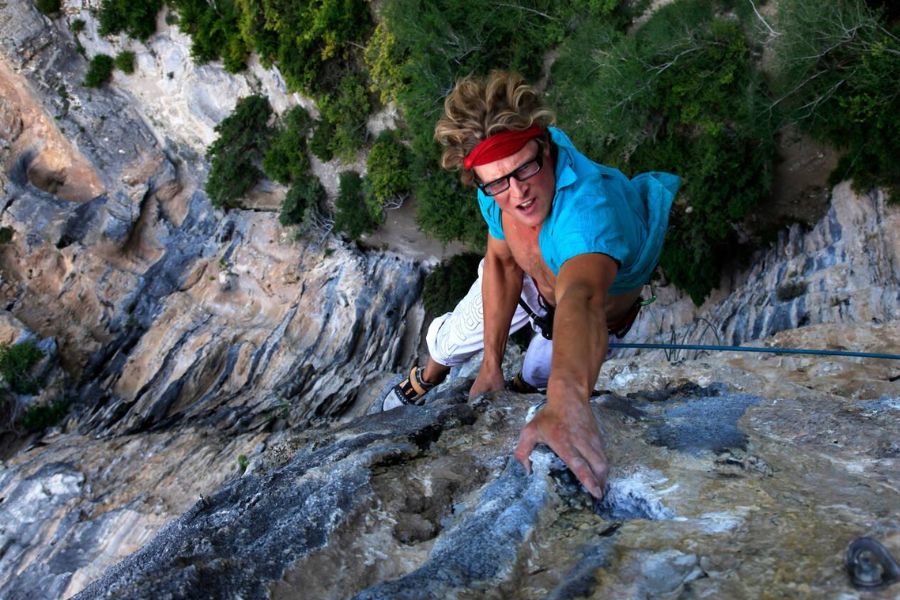
Listening to the guide’s instructions really made a difference. Knowing how to spot escape routes, checking water flow, and never canyoning alone—these are the basics.
Even if you’re experienced, local guides know the land better than anyone.
Navigating Transportation and Access
Reaching the canyons isn’t tough, but you’ll pretty much need a car. Public transport to villages like Alquézar or Rodellar is limited.
I rented a small car and found parking near most trailheads.
Main roads wind through Huesca province, and signs point to popular canyons. Some access points are just a quick walk from parking, but others—like Formiga or Oscuros de Balces—start farther out.
I packed light and wore quick-drying clothes for those longer walks.
Local adventure companies often handle group transport to the start of the route. If you’re solo, arranging a return trip (especially for point-to-point canyons) is key—sometimes a shared taxi or shuttle saves a lot of hassle.
A map or GPS kept me on track, since rural road signs can be confusing. Out here, getting to the trailhead is part of the journey.
My Personal Descent: A Thrilling Day in the Canyons
The adventure started even before we reached the canyon—nerves and excitement built as our group geared up, surrounded by limestone cliffs and the rush of water below.
Canyoning in Sierra de Guara blends real excitement, wild scenery, and moments that stick with you long after you dry off.
Cold water, jumps, slides, wildlife, and a final descent that pushed my limits—yeah, it was unforgettable.
Stepping Into Cool Waters: First Impressions
I stepped into the stream, and wow—the cold water jolted me awake. Even in a wetsuit, that first step was a shock.
Our guide explained safety tips in simple Spanish, joking about “agua fría” to break the ice and calm everyone’s nerves.
Smooth, pale limestone walls surrounded us, making the canyon feel like a secret world. The water was crystal clear, sometimes moving fast, sometimes pooling up.
Little fish darted around my feet, flashes of silver in the sunlight.
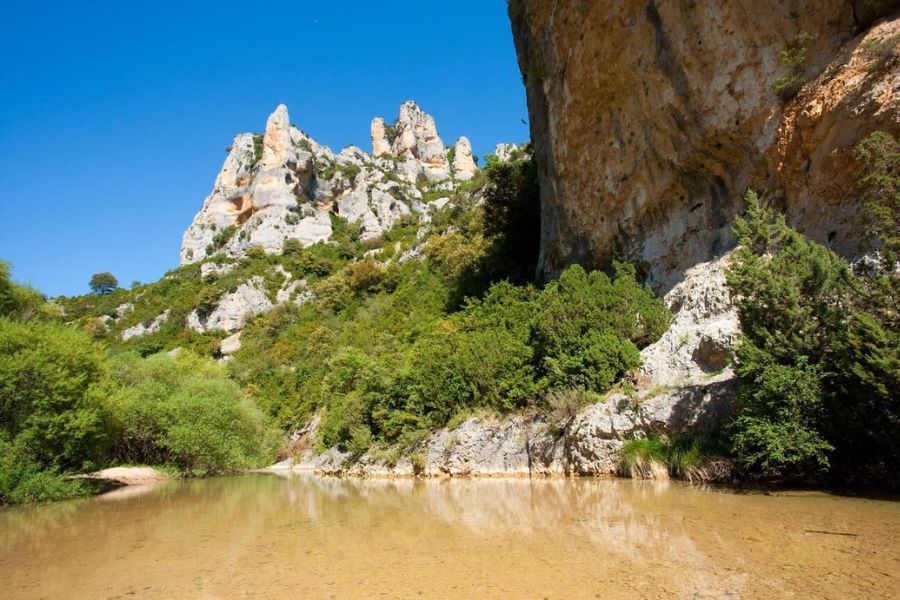
Echoes of voices and splashing water bounced off the walls, making the place feel huge. Gear clinked, helmets caught the light, and anticipation grew as we got ready for the real challenges.
Walking through narrow stone corridors, every step felt like exploring somewhere few people ever see.
| Gear Checklist | Notes |
|---|---|
| Wetsuit | For warmth and protection |
| Helmet | Always required |
| Sturdy Shoes | Good grip needed |
| Harness | For abseiling/safety |
Tackling Adrenaline-Packed Jumps and Slides
The first big challenge came—a natural slide carved by years of rushing water. My heart pounded as I watched others disappear in a splash, everyone cheering.
When my turn came, the icy spray hit my face and I shot down into a deep pool, adrenaline kicking in hard.
Next up: jumps into those blue-green pools. The guide pointed out where to leap and land safely.
Looking down, I took a deep breath, counted “uno, dos, tres” in my head, and jumped. That split second of free-fall felt endless.
All I heard was the wind and laughter echoing off the canyon walls.
These jumps and slides weren’t just about thrills—they showed how nature and local culture come together. Guides mixed safety tips with encouragement, switching between Spanish and English, so everyone felt included and a little braver.
After every jump, someone handed out a fist bump and a “muy bien!”
- Top Tip: Trust your guides. They know every twist, drop, and slippery spot—seriously, listen up.
Moments of Awe: Wildlife and Natural Beauty
About halfway through, we paused long enough for a moment of awe. Up above, griffon vultures circled in the warm air, and a breeze carried the smell of wild thyme.
Wading through shallow streams, I spotted tadpoles and bright dragonflies skimming the surface.
The rocky walls soared overhead, streaked with orange and white. Moss and tiny ferns filled pockets where water trickled down, turning stone into living art.
Midday sunlight bounced off the water, sending sparkles up toward hidden swallows’ nests tucked in the crags.
Spanish culture runs deep here. Locals treat the land with real respect, and our guide paused to share stories about the Sierra and its legends.
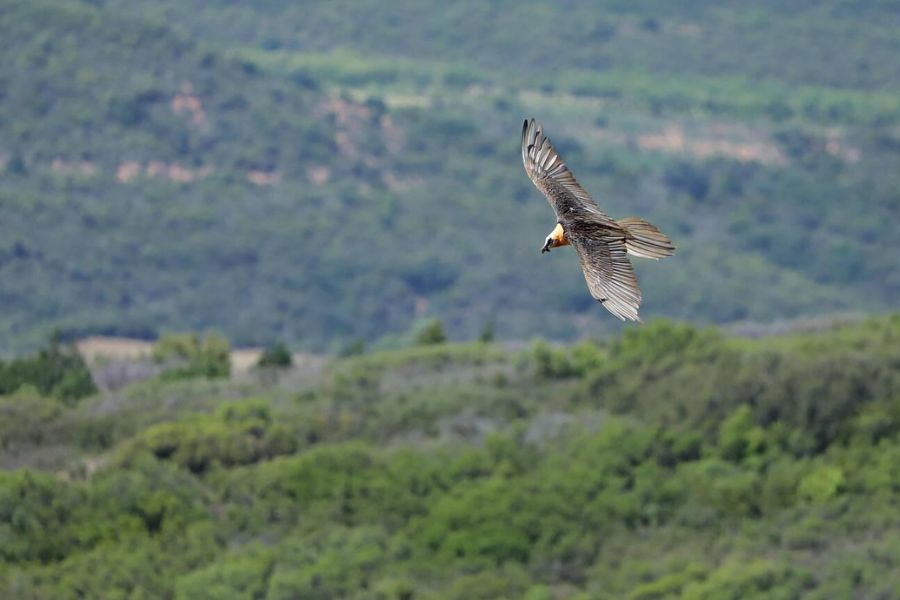
Those tales made each turn and hidden pool feel more meaningful, connecting the adventure to Aragon’s history and pride.
- Common sightings:
- Griffon vultures
- Swallows
- Fish and tadpoles
- Wildflowers and aromatic herbs
A Splash to Remember: Conquering the Final Descent
The canyon walls closed in, and suddenly, I heard the roar of water—the last challenge was here: a waterfall abseil. My heart thudded as I clipped onto the rope and checked my harness again, feeling grateful for the guide’s calm instructions in both English and Spanish.
I slid down beside the falls, cold mist smacking my face. Each meter down, that feeling of accomplishment just grew. The drop wasn’t skyscraper-high, but honestly, it felt huge—definitely something to celebrate.
When I landed in the foaming pool below, the group’s cheers echoed off the rocks. I laughed and shared a quick “lo logramos” with the guide, both of us grinning.
Looking back up at the falls, I realized the adventure felt complete. Every jump, climb, and splash wove together memories I know I’ll never lose—my own little piece of Spain’s canyoning legend.
Beyond Canyoning: More Outdoor Adventures in Aragon and Beyond
Traveling through northern Spain, I quickly realized there’s so much more than canyoning. Adventurers can head into old mountain ranges, climb rocky peaks, carve through the snow, or wander peaceful coastal trails.
Hiking Trails Through the Catalan Pyrenees
The Catalan Pyrenees have endless trails for every level. I spent a week hiking there and honestly, the mix of jagged peaks, green forests, and tiny stone villages blew me away.
Trails like the Carros de Foc loop link mountain refuges with epic views of lakes and meadows. Most paths are well-marked, and many wind through Aigüestortes i Estany de Sant Maurici National Park.
Glacial lakes and wildflower meadows made each day feel fresh. If you’re up for a bigger challenge, the GR11 route crosses the entire Spanish Pyrenees.
Packing a windbreaker, sturdy shoes, and layers kept me comfortable. Trails near Vall de Núria work great for families, while the higher routes near Andorra pull in the more experienced hikers.

Don’t miss: Spotting marmots and catching the sunrise over the ridges.
Exploring Montserrat and Nearby Hotspots
Montserrat rises with its weird stone towers and deep ravines, just an hour from Barcelona. I remember watching morning mist drift between the spires as I hiked toward the Santa Maria de Montserrat Abbey.
The mountain draws both pilgrims and adventure seekers. The Cami de les Aigües offers gentle walks, while the Sant Jeroni paths climb steeply for big views. Climbing and scrambling are just as common—I saw plenty of people scaling the giant stone “fingers.”
Nearby towns like Manresa and the Penedès wine region invite you in after a busy morning. I loved ending the day with a glass of cava and some local tapas.
Tip: Public transport connects Montserrat and Barcelona, so it’s easy to plan a quick trip or even stay overnight.
Skiing and Winter Activities
Skiing in northern Spain totally surprised me. Aragon’s mountain resorts like Formigal and Candanchú turn the Pyrenees into a snowy playground.
Wide open pistes, easy beginner slopes, and tough runs all come together. My favorite part? The view from the top of the lifts—just wow.
Winter isn’t only about downhill skiing. I tried snowshoeing through quiet forests and even gave cross-country skiing a shot at Llanos del Hospital.
The villages near the resorts felt cozy and welcoming, with family-run hotels and hearty food. Rental shops made it easy to get gear, even for a first-timer like me.

Some places even offer night skiing, which I thought was especially fun with the slopes glowing under the dark sky.
Must pack: Warm gloves, goggles, and a bit of extra energy for those long days out in the snow.
From Galicia to Costa de la Luz: Spanish Adventure Trails
From Galicia’s misty cliffs in the northwest to the golden sands of Costa de la Luz down south, Spain is packed with trails. I loved hiking the Camiño dos Faros (the Lighthouse Way) in Galicia, where wild Atlantic waves crash against hidden coves.
Further south, Costa de la Luz has coastal paths that wind past dunes and pine forests. Walking or cycling, you’ll end the day with the sound of surf in your ears. Doñana National Park, not far from the coast, is a must for birdwatchers and nature fans.
Quick guide:
| Region | Main Activity | Highlights |
|---|---|---|
| Galicia | Coastal Hiking | Cliffs, lighthouses, seafood |
| Costa de la Luz | Coastal Hiking, Cycling | Sand dunes, surf, sunsets |
| Doñana National Park | Wildlife Watching | Marshlands, rare birds |
Exploring these quieter trails let me see a wilder side of Spain—far from the crowds, close to the land.
Practical Tips: Accommodation, Dining, and Local Experiences
Finding a great place to stay, eat, and explore really makes a trip to Sierra de Guara. My canyoning days felt even better thanks to unique lodgings, tasty local food, and good company.
Unique Lodgings Near Sierra de Guara
After a day in the water, I just wanted a comfortable bed. I found plenty of options, from cozy rural casas rurales in the hills to simple hostels in Rodellar, which has a real canyoning vibe.
I stayed with a local family in Alquézar. Their guesthouse had stone walls and a patio lined with flowers—super homey. If you want more comfort, Barbastro has small hotels with modern touches. Some places even serve homemade breakfasts with local honey and jam.
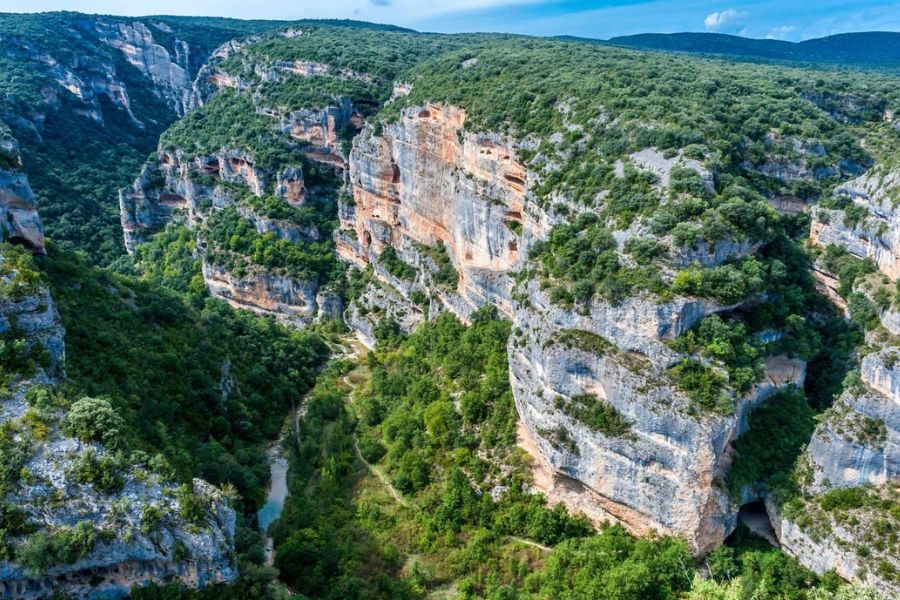
Here’s a quick table of my favorite stay types:
| Lodging Type | Location | Perks |
|---|---|---|
| Guesthouse | Alquézar | Local food, friendly hosts |
| Hostel | Rodellar | Budget-friendly, social vibe |
| Small Hotel | Barbastro | Modern, comfortable, quiet |
Booking ahead is smart, especially in summer.
Savoring Local Cuisine and Dining Spots
After hours in the river, food shot to the top of my list. Traditional Aragonese dishes fill most menus—think ternasco (roast lamb), hearty stews, and migas (fried breadcrumbs with sausage or chorizo).
Many restaurants in Alquézar and nearby villages use local produce and wine from Somontano. One night, I ate at a small spot overlooking the canyon. The view was great, but the grilled river trout with fresh asparagus really stole the show.
Tapas bars in Huesca serve all kinds of quick bites—perfect for sharing with friends.
Some tasty finds:
- Roast lamb (ternasco)
- Migas with chorizo
- Local goat cheese
- Somontano red wine
If you want a table at popular places, book ahead, especially for dinner.
Festivals and Spanish Culture Immersion
Cultural events open up a whole new side of the region. Villages hold patron saint festivals with music, fireworks, and processions. In early summer, Barbastro throws a lively wine festival that’s all about local bottles and food.
I stumbled into a fiesta in Alquézar, with dancing in the square and open-air concerts that went late into the night. These gatherings made me feel like part of the community.
Trying out a few words of Spanish with locals always helped make connections. People’s warmth and pride in their traditions really stood out.
Planning with Friends: Shared Travel Insights
Traveling with friends made everything richer. We split the cost of a rental car, which made hopping between towns and trailheads way easier.
Booking guesthouses as a group saved money and made evenings more fun after long days out. We divided up the trip chores—one of us found dinner spots, another booked activities.
After canyoning, we’d gather to swap stories and laugh over the day’s best (and worst) moments.
If you’re traveling with a group, communication and flexibility really help. Sharing the planning and the memories made every part of the trip sweeter.
Unveiling Aragon: History, Traditions, and Travel Routes
Aragon is full of ancient stories, unique customs, and scenic roads waiting to be explored. The past mixes with the present in every stone, trail, and celebration, giving you endless ways to dive into this Spanish region’s culture.
Legacy of the Alpujarran and Other Autonomous Communities
Traveling through Aragon, I quickly spotted the marks left by different communities, especially echoes from the Alpujarran people. While the Alpujarran are mostly tied to southern Spain, their Moorish influence still shapes Spain’s broader history, including Aragon.
Aragon stands as one of Spain’s 17 autonomous communities. It has its own government and traditions, shaped by centuries of shifting rulers and borders.
Gothic churches and medieval villages show off a mix of Christian, Islamic, and Jewish heritage. Local festivals highlight rituals that have been passed down for generations.
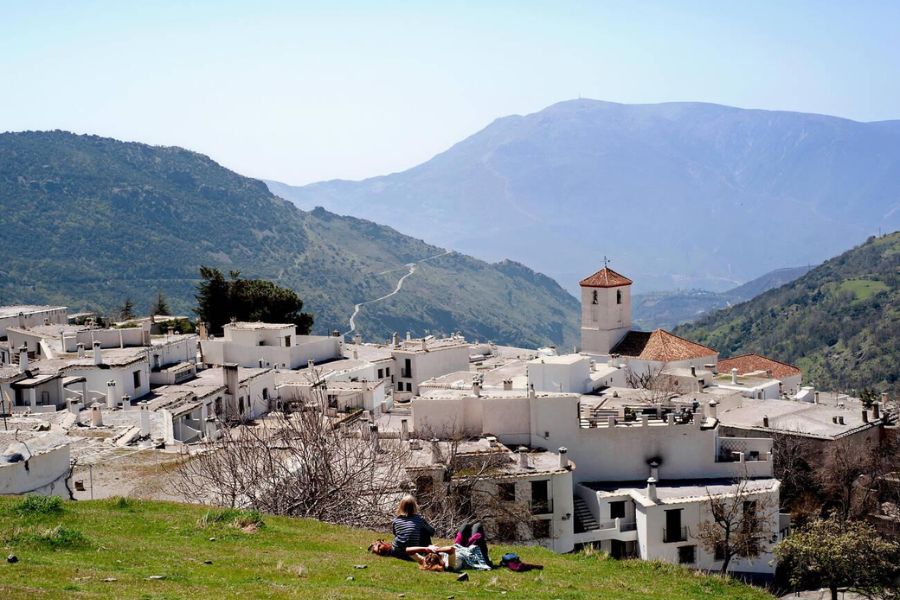
I watched folk dancers swirl through plazas, their costumes bright reminders of a history that links Aragon to neighboring regions like Catalonia and Navarre. Sometimes it felt like I’d stepped into a living museum.
Camino de Santiago: Pilgrim Paths and Spiritual Journeys
The Camino de Santiago, or the Way of St. James, crosses northern Spain and touches parts of Aragon. People from all over the world walk or bike these old trails, searching for quiet, adventure, or maybe something deeper.
Along Aragon’s Camino routes, I found rustic churches and simple village inns. Pilgrim hostels dot the path, each one a welcome break after long, dusty miles.
Signposts with the scallop shell symbol point the way, just as they have for centuries. I met other travelers who swapped stories over bread and cheese. There’s a strong sense of community and shared purpose in every step.
If you love history, walking the Camino here lets you experience a tradition that connects locals and visitors through faith and discovery.
Storybook Vistas and Hidden Gems
I wound along twisting roads and found myself staring out at wild canyons, rolling hills, and rivers cutting deep into green valleys.
Little towns like Alquézar just sit there, almost untouched, their cobbled streets curling around old castles.
When I left the main highways, I ran into family-run taverns serving up migas and ternasco (that’s roast lamb, if you’re curious).
Locals pointed me in the right direction, sometimes with a story or two you’d never find in a guidebook.
If you want a quick peek at what Aragon’s got, here’s a table I put together:
| Place | What to See | Don’t Miss |
|---|---|---|
| Alquézar | Old Town, Collegiate Church | Walk through Vero Canyon |
| Aínsa | Medieval Square | Climb the castle tower |
| Bierge | Waterfalls | Local olive oil tasting |
Every view and village felt like a secret—something you just happen upon.
Traveling across Aragon, I realized it’s not just another spot on the map. It’s more like an open invitation to wander, taste new things, and meet people along the way.

